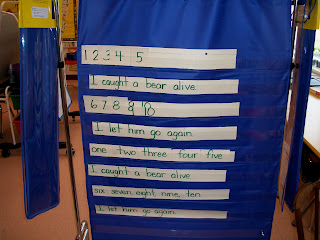In math, we learned about the dime and reviewed the penny and the nickel. We also played, "I Spy" with two-dimensional and three-dimensional shapes. To play, "I Spy" I gave clues that described items that can be found in the classroom. For example, I would say this shape is a three-dimensional shape and can be used for writing. The student would then identify the marker and tell the class the shape. The students also practiced one-to-one correspondence with the "tricky" teens at the math workstation.
In reading, we continue to practice our sight words during our class meeting and during guided reading. The students also learned how to create sensory images while reading, which helps with reading comprehension. To practice this strategy I read, "Pancakes, Pancakes" by Eric Carle. As I read, I modeled how to create a sensory image using the five senses. After I modeled this several times, I encouraged the students to create sensory images as I read. The students seemed to really enjoy working with this strategy.
In writing, we created a book about the four seasons. Also, we talked about the components of a sentence, which include a capital letter at the beginning, spaces between each word, and a period at the end of the sentence. We created several sentences together during a whole group lesson. The students could then practice rearranging the sentences while at the pocket chart workstation. The students also learned how to write the lowercase v, w, and t.
In social studies, the students learned about needs and wants. During a whole group lesson, the students and I worked together to sort pictures on a T-chart that was labeled, "needs" and "wants."
Pictures of workstations:

Sorting pictures by the beginning sounds at pocket chart workstation

Writing about a tree house the students would like to build at writing workstation

Practicing corner starter letters at handwriting workstation

Building "ay" words and finding pictures with short i at ABC/word study workstation










